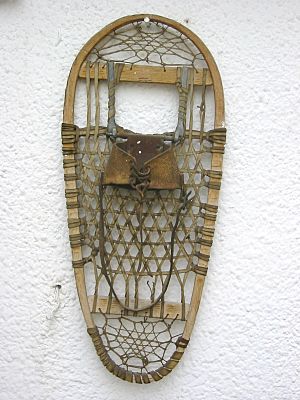Battle on Snowshoes (1757) facts for kids
Quick facts for kids First Battle on Snowshoes |
|||||||
|---|---|---|---|---|---|---|---|
| Part of the French and Indian War | |||||||
 A traditional snowshoe |
|||||||
|
|||||||
| Belligerents | |||||||
| Commanders and leaders | |||||||
Charles Michel de Langlade |
|||||||
| Strength | |||||||
| 179 regulars, Canadiens and Indians | 74 | ||||||
| Casualties and losses | |||||||
| 11 killed 27 wounded |
14 killed 9 wounded 6 missing or captured |
||||||
The 1757 Battle on Snowshoes was a small fight during the French and Indian War. It happened on January 21, 1757. This battle got its name because the British soldiers wore snowshoes.
Captain Robert Rogers led his special group of soldiers, called Rogers' Rangers. They were scouting near Fort Carillon (now Fort Ticonderoga) when French and Indian troops surprised them. The fight lasted until dark. Both sides had many soldiers killed or hurt. The French later said the British had an advantage because of their snowshoes.
What Caused the Battle?
The French and Indian War started in 1754. It was a fight between British and French colonists. They argued over land in North America. The next year, regular soldiers joined the fight.
By 1756, the French were winning most battles. Their only big loss was at the 1755 Battle of Lake George. The French and their Indian allies kept scouting British forts. These forts were on Lake George and the Hudson River.
The British had fewer Indian allies. So, they used special groups of soldiers called rangers. These rangers were good at scouting and exploring. Robert Rogers organized these groups. They became famous as Rogers' Rangers.
Before the Fight
In the winter of 1757, Captain Rogers and his rangers were at Fort William Henry and Fort Edward. These forts were on the border between British New York and French Canada.
On January 15, Rogers led a scouting trip from Fort Edward. He picked up supplies and more soldiers at Fort William Henry. On January 17, his group of 86 men left. They walked north on the frozen Lake George.
The next day, 12 men had to turn back due to injuries. The rest kept going. On January 21, they reached Lake Champlain. They saw a sled moving toward Fort St. Frédéric. Rogers sent some men to stop it.
More sleds appeared, and the rangers were seen. The sleds turned back toward Fort Carillon. The British chased them, but most French escaped. Rogers did manage to capture seven prisoners.
Rogers questioned the prisoners. He learned that a French and Indian war party had just arrived at Carillon. He also found out that the forts had many soldiers. Rogers worried the escaped sleds would warn the French. He ordered his men to return to their last camp.
His officers disagreed with taking the same route back. Rogers usually taught against this. But he said they needed to be fast because of the deep snow. By afternoon, they were back at camp. After a rest, they started heading south again.
Meanwhile, the French leader of the supply convoy, M. de Rouilly, reached Carillon. He told the fort commander, Paul-Louis de Lusignan, what happened. Lusignan quickly sent out a group of about 90 French soldiers. About 90 Canadian militia and Indians joined them. The Indians were mainly Ottawa warriors. They were led by Charles Michel de Langlade.
The Battle Begins
Rogers' men walked right into a surprise attack. Rogers thought there were about "250 French and Indians." The British were lucky that many French muskets did not fire. This was because of wet gunpowder.
Lieutenant John Stark was at the back of the ranger group. He quickly set up a defense line on a small hill. His men fired to cover the others. The rangers at the front retreated to this safe spot. As they pulled back, Rogers ordered his prisoners to be killed. This allowed his men to move more easily.
The fight lasted for several hours. It only stopped after sunset, when it was too dark to see. Rogers was hurt twice during the battle. He was hit in the head and the hand. The French later said they were at a disadvantage. They did not have snowshoes and were "floundering in snow up to their knees."
Once it was dark, Rogers and his remaining men retreated about 6 miles (10 km) to Lake George. Rogers sent Stark and two men to Fort William Henry for help. On January 23, Rogers returned to Fort William Henry. He had 48 healthy soldiers and six wounded ones.
What Happened Next?
A French officer questioned some of the captured British soldiers. He learned about the British soldiers and supplies from Albany to Fort William Henry. Other captured British soldiers became slaves to the Indians. One soldier, Thomas Brown, wrote about his time as a slave. He was a slave for almost two years. He traveled far, even to the Mississippi River. He finally reached Albany in November 1758.
A similar battle happened the next year. In that fight, Rogers was almost killed, and his company lost many men.


